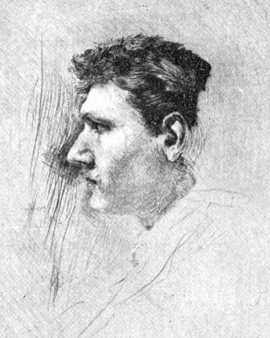Robert Frederik Blum was born into a troubled time. When he saw the light of day in Cincinnati, the Civil War was raging in what is now the United States. His parents were immigrants of German descent. Blum's father had made the adventurous journey from Germany across the Atlantic to New Orleans on a sailing ship. Influenced by these experiences and life in the German Quarter Over-the-Rhine, where hard work was the order of the day, Robert Frederik Blum's parents were not thrilled that their son loved drawing.
At the age of 16, the talented young Robert could no longer be contained and left high school to train as a lithographer. In addition, he attended evening art classes. At a festival where Japanese fans were sold, he is said to have first become aware of Japanese culture and immediately purchased several copies for drawing studies. Later, while attending art school in Philadelphia, he finally lost his heart to the Far Eastern country at a Japan exhibition. However, his desire for travel and adventure first took him to Europe, where he further developed his Impressionist painting technique in oil and watercolor in cities such as Madrid and Venice.
A new world opened up for the artist when he got his hands on pastels. Blum, who already had a great talent for bringing light and mood not only visibly but almost tangibly to the canvas, perfected his technique with the use of this new color material. Pastels made it possible for him to capture for eternity an even more fleeting, elusive atmosphere. Now he could capture the subdued light even more delicately and poetically. When Robert Frederik Blum is 33 years old, he embarks on a journey he has dreamed of since his youth. He sets off for Japan. In America at the end of the 19th century, people have only the faintest idea of how they live in Japan. At the same time, the people's enthusiasm and inquisitiveness about the country is growing. Robert Frederik Blum is commissioned by a magazine to capture the daily life of the people in Japan in pictures. Once there, he is overwhelmed by the life and culture of the Japanese. He portrays everyday scenes, faces, mothers with children, and ornate robes. He becomes the first American artist to paint images of Japan and bring them to his homeland.
Robert Frederik Blum's position in the art world of his time was outstanding. His works had made him famous and he counted some of the greatest artists of the time among his close friends. At the age of 64, he died in New York after contracting pneumonia. His great love, Flora de Stephano, whom Blum had painted several times, claimed to be his widow after his death. She then received a small sum of money, some of the artist's personal belongings and three of his works.
×





.jpg)
.jpg)
.jpg)
.jpg)
.jpg)
.jpg)
.jpg)
.jpg)
.jpg)
.jpg)
.jpg)
.jpg)
.jpg)
.jpg)
.jpg)
.jpg)
.jpg)
.jpg)
.jpg)
.jpg)
.jpg)
.jpg)
.jpg)
.jpg)
.jpg)
.jpg)
.jpg)
.jpg)
.jpg)
.jpg)
.jpg)
.jpg)
.jpg)
.jpg)
.jpg)
.jpg)
.jpg)
.jpg)
.jpg)
.jpg)
.jpg)
.jpg)
.jpg)
.jpg)
.jpg)
.jpg)
.jpg)
.jpg)
.jpg)
.jpg)
.jpg)
.jpg)
.jpg)
.jpg)
.jpg)
.jpg)
.jpg)
.jpg)
.jpg)
.jpg)
.jpg)
.jpg)
.jpg)
.jpg)
.jpg)
.jpg)
.jpg)
.jpg)
.jpg)
.jpg)
.jpg)
.jpg)
.jpg)
.jpg)
.jpg)
.jpg)
.jpg)
.jpg)
.jpg)
.jpg)
.jpg)
.jpg)
.jpg)
.jpg)
.jpg)
.jpg)
.jpg)
.jpg)
.jpg)
.jpg)
.jpg)
.jpg)
.jpg)
.jpg)
.jpg)
.jpg)
.jpg)
.jpg)
.jpg)
.jpg)
.jpg)
.jpg)
.jpg)
.jpg)
.jpg)
.jpg)
.jpg)
.jpg)
.jpg)
.jpg)
.jpg)
.jpg)
.jpg)
.jpg)
.jpg)
.jpg)
.jpg)
.jpg)
.jpg)
.jpg)
.jpg)
.jpg)
.jpg)
.jpg)
.jpg)
.jpg)
.jpg)
.jpg)
.jpg)
.jpg)
.jpg)
.jpg)
.jpg)
.jpg)
.jpg)
.jpg)
.jpg)
.jpg)
_1897_(Oil_pastel_and_pencil_on_canvas)_-_(MeisterDrucke-1482833).jpg)
_1897_(Oil_pastel_and_pencil_on_canvas)_-_(MeisterDrucke-1482833).jpg)
.jpg)
.jpg)
.jpg)
.jpg)
.jpg)
.jpg)
.jpg)
.jpg)
.jpg)
.jpg)
.jpg)
.jpg)
.jpg)
.jpg)
.jpg)
.jpg)
.jpg)
.jpg)
.jpg)
.jpg)
.jpg)
.jpg)
.jpg)
.jpg)
.jpg)
.jpg)
.jpg)
.jpg)
.jpg)
.jpg)
.jpg)
.jpg)
.jpg)
.jpg)
.jpg)
.jpg)
.jpg)
.jpg)
.jpg)
.jpg)
.jpg)
.jpg)
.jpg)
.jpg)
.jpg)
.jpg)
.jpg)
.jpg)
.jpg)
.jpg)
.jpg)
.jpg)
.jpg)
.jpg)
.jpg)
.jpg)
.jpg)
.jpg)
.jpg)
.jpg)






